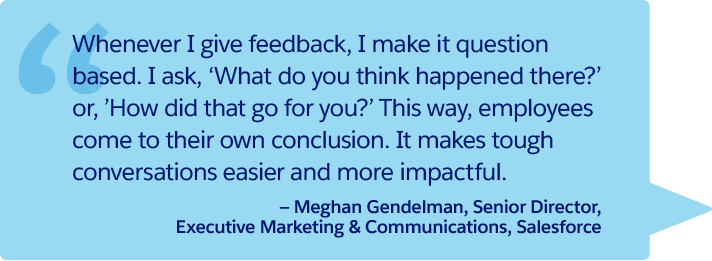Learn the Value of One-on-One Meetings
Learning Objectives
After completing this unit, you’ll be able to:
- Explain the business value of one-on-one meetings.
- Describe the elements of effective one-on-one meetings.
The Value of Effective One-on-One Meetings
Tim is a new manager with eight direct reports. He’s thrilled by the idea of managing a team and wants to learn ways to bring out the best in his people. Akira has been managing a team for more than a decade and is looking for ways to motivate and inspire her team.
Whether you’re new to managing or have years of experience, one-on-one meetings (at Salesforce, we refer to them as 1:1s) are a great way to support your own and your direct reports’ success.
These scheduled, informal meetings between you and your individual direct reports can happen almost anywhere. They can occur in an office, in a conference room, on a walk, at a coffee shop, or virtually, from your laptops.
Why are 1:1s so important? Simply put, there’s no better time to learn more about what motivates, challenges, and excites your team.

“Through 1:1s we listen to our employees, we learn their roadblocks, and we dig into what drives them.” —Carmina Coenen, Senior Manager, Solution Engineering, Salesforce Belgium
Most important, holding regular 1:1s shows your direct reports that you’re invested in them, their goals, their success, and their careers.
Holding regular 1:1s results in:
Increased engagement |
Employees whose managers hold regular 1:1s are three times as likely to be engaged in their work. |
|---|---|
Greater productivity |
Highly engaged employees are 22% more productive than disengaged employees. |
Fewer roadblocks |
Managers who meet regularly with their direct reports are more successful in gaining alignment, providing support, and overcoming project hurdles. |
Still not convinced 1:1s are worth your time? Disengaged employees are four times more likely to leave their job. Think of all the time it takes to interview, hire, and train a new employee—that’s time better spent getting to know and cultivate the employees you already have.
So let’s turn less engaged employees into more engaged ones. Let’s help our direct reports be their most productive and happy. Let’s commit to holding 1:1s!
Commit to One-on-One Meetings
As a manager, committing focused time to your employees might seem tough at first. You’re getting pulled in every direction as you steer your team through the next release, customer pitch, or marketing campaign. Maintaining the discipline to meet with your team members week after week throughout the year is like prepping for a marathon. You and your direct reports need regular workouts, fuel, and stamina to go the full 26.2 miles.
But we all know how hard it can be to reach the finish line. Maybe an injury flares up, motivation wanes, or exhaustion sets in. Just like running coaches schedule check-ins with their athletes, consistent 1:1 meetings with your direct reports help them chase their goals.

“As a marathon runner, I think of 1:1s as a way to ensure we are aligned on the best path to achieve the goal, as well as a point to pick up water to hydrate to ensure we are prepared to go the distance." —Mark Hawkins, CFO, Salesforce
How do you commit to 1:1s?
Do This |
Not This |
|---|---|
|
Set a regular cadence and schedule One manager at Salesforce meets with her direct reports for 30 minutes each week. Another manager meets with his direct reports for 60 minutes every other week. Find a cadence that works for you. |
Meet only sporadically Don’t randomly add a 1:1 meeting on your direct reports' calendar without explaining that you’ll be starting up regular 1:1s with all your direct reports. |
|
Clarify whose role it is to schedule 1:1s Ask your direct report to schedule an agreed upon recurring time slot. If it helps, ask for editing privileges so that you can propose and agree upon a new meeting time if an unforeseen scheduling conflict arises. |
Assume your direct reports will schedule 1:1s as needed Don’t forget to mention to your direct reports that you’d like them to schedule the meetings. |
|
Keep 1:1s sacred Respect the time that you’ve allotted for 1:1s. Remember you can always use the time to take a walk or grab coffee together. 1:1s can happen anywhere–it’s the dedicated time and attention that count the most. |
Cancel the 1:1 without rescheduling Don’t fill your calendar with 1:1s only to cancel them without rescheduling. Remember the impact 1:1s have on engagement and productivity. |
What Makes for a Great One-on-One Meeting
You can see why 1:1s are so important, but what makes for a great 1:1? That’s easy! It starts with your time, attention, and willingness to provide support. That’s the commitment part.
From there, four other elements make up a great 1:1:
- Connection
- Inspiration
- Alignment
- Feedback
Connection
Take your time and really connect. Don't speed through status reports and task lists. Just relax and start your 1:1s with, “How are you doing?” You can even ask, “How was your weekend?”

“My team is like my family. I genuinely care about them and what is happening in their lives.” —Ansar Ahmed, Senior Director, Solution Engineering, Salesforce, London
Connection is all about getting to know your direct reports on a personal level and showing you care about them as people with lives outside of work. You can even put your laptop down and invite them for coffee or lunch to start building a personal relationship beyond deadlines and deliverables.
The simple act of connecting with your team helps build trust and understanding. These stronger relationships help everyone navigate stress, misunderstandings, and roadblocks.
We’ll talk more about connection in the next unit.
Inspiration
As we mentioned, providing inspiration is a lot like coaching—it involves giving your direct reports the advice, guidance, and resources they need to be star players. But it goes beyond that. A 1:1 is your opportunity to let your direct reports know that you empathize with them when they are stressed out and in need of a pep talk. Inspire your direct reports by sharing stories from your career about how you navigated through hard times and what you learned along the way.

“One of the biggest values of 1:1s is discovering where employees are struggling or stuck, and helping them find a path forward. Not by telling them how you'd do it, but by guiding them to come up with their own solution.” —Jon Plax, Senior Director, Customer Centric Engineering, Salesforce
Want to learn more about how to coach and inspire your team to greatness? Check out Coaching and Developing Others and Inspire Your Team with Stories .
Alignment
Almost nothing is more important than ensuring your team is on the same page and pursuing the right goals. Of course, we’re not suggesting that your 1:1s be solely focused on status updates. Rather, great 1:1s provide your employees with a sense of direction and clarification on their projects, priorities, and even career goals.

“1:1s help ensure you are aligned and on course each and every step of the way." —Mark Hawkins, CFO, Salesforce
Alignment is so important to us at Salesforce that we have our own unique method for staying aligned on goals and strategies across the company: the V2MOM. To learn more about how to use the V2MOM, check out Organizational Alignment (V2MOM) .
Feedback
Consistent and timely feedback drives individual performance and company success. More and more companies recognize this and are dropping annual reviews. Feedback can't wait, and there’s no better time to exchange feedback than during your 1:1s.

“Whenever I give feedback, I make it question based. I ask, ‘What do you think happened there?’ or, ’How did that go for you?’ This way, employees come to their own conclusion. It makes tough conversations easier and more impactful.” —Meghan Gendelman, Senior Director, Executive Marketing & Communications, Salesforce
Since feedback is a two-way street, 1:1s are also an opportunity to ask for and receive feedback about what you can do better, too.
Let’s Sum It Up

We hope by now you’re convinced that holding regular 1:1s results in more engagement, more productivity, and fewer roadblocks for everyone!
In the next two units, we’ll share top tips from some of our best managers at Salesforce to help you conduct amazing 1:1s.
Resources
- 4 Steps to Better Your Boss-Employee Relationship
- The Secret To Effective One-On-One Meetings With Direct Reports
- Employees Want a Lot More From Their Managers
